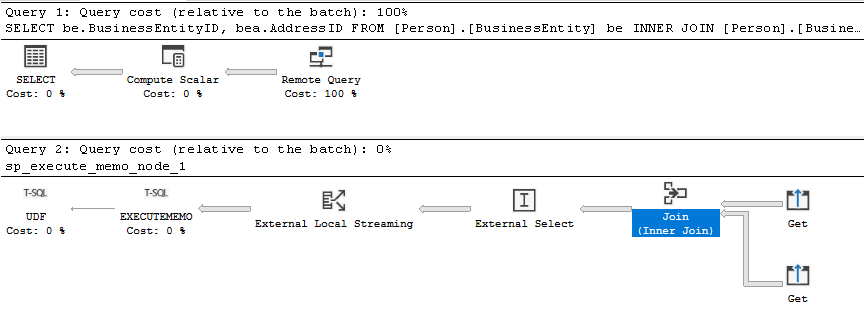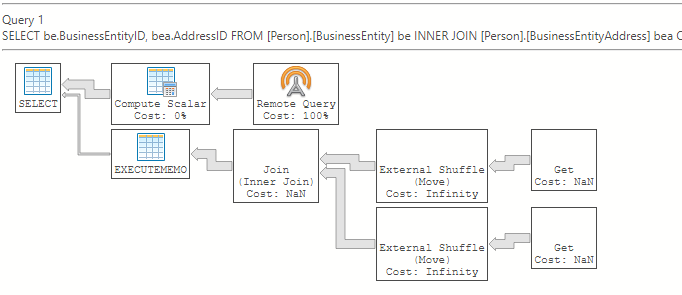How to tell if external pushdown occurred
This article details how to determine if a PolyBase query is benefitting from pushdown to the external data source. For more information on external pushdown, see pushdown computations in PolyBase.
Is my query benefitting from external pushdown?
Pushdown computation improves the performance of queries on external data sources. Certain computation tasks are delegated to the external data source instead of being brought to the SQL Server. Especially in the cases of filtering and join pushdown, the workload on the SQL Server instance can be greatly reduced.
PolyBase pushdown computation can significantly improve performance of the query. If a PolyBase query is performing slowly, you should determine if pushdown of your PolyBase query is occurring.
There are three different scenarios where pushdown can be observed in the execution plan:
- Filter predicate pushdown
- Join pushdown
- Aggregation pushdown
Note
There are limitations on what can be pushed down to external data sources with PolyBase pushdown computations:
- Some T-SQL functions can prevent pushdown, for more information, see PolyBase features and limitations.
- For a list of T-SQL functions that can otherwise be pushed down, see Pushdown computations in PolyBase.
Two new features of SQL Server 2019 (15.x) have been introduced to allow administrators to determine if a PolyBase query is being pushed down to the external data source:
- View the Estimated Execution Plan with trace flag 6408
- View the
read_commandin the sys.dm_exec_external_work dynamic management view
This article provides details on how to use each of these two use cases, for each of three pushdown scenarios.
Use TF6408
By default, the estimated execution plan does not expose the remote query plan, and you only see the remote query operator object. For example, an estimated execution plan from SQL Server Management Studio (SSMS):

Or, in Azure Data Studio:

Starting in SQL Server 2019 (15.x), you can enable a new trace flag 6408 globally using DBCC TRACEON. For example:
DBCC TRACEON (6408, -1);
This trace flag only works with estimated execution plans and has no effect on actual execution plans. This trace flag exposes information about the Remote Query operator that shows what is happening during the Remote Query phase.
Execution plans are read from right-to-left, as indicated by the direction of the arrows. If an operator is to the right of another operator, it is said to be "before" it. If an operator is to the left of another operator, it is said to be "after" it.
- In SSMS, highlight the query and select Display Estimated Execution Plan from the toolbar or use Ctrl+L.
- In Azure Data Studio, highlight the query and select Explain. Then consider the following scenarios to determine whether pushdown occurred.
Each of the below examples includes the output from SSMS and Azure Data Studio.
Pushdown of filter predicate (view with execution plan)
Consider the following query, which uses a filter predicate in the WHERE clause:
SELECT *
FROM [Person].[BusinessEntity] AS be
WHERE be.BusinessEntityID = 17907;
If pushdown of the filter predicate is occurring, the filter operator is before the external operator. When the filter operator is before the external operator, the filtering occurred before getting selected back from the external data source, indicating the filter predicate was pushed down.
With pushdown of filter predicate (view with execution plan)
With the Trace Flag 6408 enabled, you now see additional information in the estimated execution plan output. The output varies between SSMS and Azure Data Studio.
In SSMS, the remote query plan is displayed in the estimated execution plan as Query 2 (sp_execute_memo_node_1) and corresponds to the Remote Query operator in Query 1. For example:

In Azure Data Studio, the remote query execution is instead represented as a single query plan. For example:

Without pushdown of filter predicate (view with execution plan)
If pushdown of the filter predicate is not occurring the filter will be after the external operator.
The estimated execution plan from SSMS:

The estimated execution plan from Azure Data Studio:

Pushdown of JOIN
Consider the following query that utilizes the JOIN operator for two external tables on the same external data source:
SELECT be.BusinessEntityID, bea.AddressID
FROM [Person].[BusinessEntity] AS be
INNER JOIN [Person].[BusinessEntityAddress] AS bea
ON be.BusinessEntityID = bea.BusinessEntityID;
If the JOIN is pushed down to the external data source, the Join operator will be before the external operator. In this example, both [BusinessEntity] and [BusinessEntityAddress] are external tables.
With pushdown of join (view with execution plan)
The estimated execution plan from SSMS:

The estimated execution plan from Azure Data Studio:

Without pushdown of join (view with execution plan)
If the JOIN is not pushed down to the external data source, the Join operator will be after the external operator. In SSMS, the external operator is in the query plan for sp_execute_memo_node, which is in the Remote Query operator in Query 1. In Azure Data Studio, the Join operator is after the external operator(s).
The estimated execution plan from SSMS:

The estimated execution plan from Azure Data Studio:

Pushdown of aggregation (view with execution plan)
Consider the following query, which uses an aggregate function:
SELECT SUM([Quantity]) as Quant
FROM [AdventureWorks2022].[Production].[ProductInventory];
With pushdown of aggregation (view with execution plan)
If pushdown of the aggregation is occurring, the aggregation operator is before the external operator. When the aggregation operator is before the external operator, the aggregation occurred before getting selected back from the external data source, indicating the aggregation was pushed down.
The estimated execution plan from SSMS:

The estimated execution plan from Azure Data Studio:

Without pushdown of aggregation (view with execution plan)
If pushdown of the aggregation is not occurring the aggregation operator will be after the external operator.
The estimated execution plan from SSMS:

The estimated execution plan from Azure Data Studio:

Use DMV
In with SQL Server 2019 (15.x) and later versions, the read_command column of sys.dm_exec_external_work DMV shows the query that is sent to the external data source. This allows you to determine if pushdown is occurring, but does not expose the execution plan. Viewing the remote query does not require TF6408.
Note
For Hadoop and Azure storage, the read_command always returns NULL.
You can execute the following query and use the start_time/end_time and read_command to identify the query being investigated:
SELECT execution_id, start_time, end_time, read_command
FROM sys.dm_exec_external_work
ORDER BY execution_id desc;
Note
One limitation of the sys.dm_exec_external_work method is that the read_command field in the DMV is limited to 4000 characters. If the query is sufficiently long, the read_command may be truncated before you'd see the WHERE/JOIN/aggregation function in the read_command.
Pushdown of filter predicate (view with DMV)
Consider the query used in the previous filter predicate example:
SELECT *
FROM [Person].[BusinessEntity] be
WHERE be.BusinessEntityID = 17907;
With pushdown of filter (view with DMV)
You can tell if pushdown of the filter predicate is occurring by checking the read_command in the DMV. You will see something like this sample:
SELECT [T1_1].[BusinessEntityID] AS [BusinessEntityID], [T1_1].[rowguid] AS [rowguid],
[T1_1].[ModifiedDate] AS [ModifiedDate] FROM
(SELECT [T2_1].[BusinessEntityID] AS [BusinessEntityID], [T2_1].[rowguid] AS [rowguid],
[T2_1].[ModifiedDate] AS [ModifiedDate]
FROM [AdventureWorks2022].[Person].[BusinessEntity] AS T2_1
WHERE ([T2_1].[BusinessEntityID] = CAST ((17907) AS INT))) AS T1_1;
The WHERE clause is in the command sent to the external data source, which means the filter predicate is being evaluated at the external data source. Filtering on the dataset occurred at the external data source, and only the filtered dataset was retrieved by PolyBase.
Without pushdown of filter (view with DMV)
If pushdown is not occurring, you'll see something like:
SELECT "BusinessEntityID","rowguid","ModifiedDate" FROM "AdventureWorks2022"."Person"."BusinessEntity"
There is no WHERE clause in the command sent to the external data source, so the filter predicate is not pushed down. Filtering on the entire dataset occurred on the SQL Server side, after the dataset was retrieved by PolyBase.
Pushdown of JOIN (view with DMV)
Consider the query used in the previous JOIN example:
SELECT be.BusinessEntityID, bea.AddressID
FROM [Person].[BusinessEntity] be
INNER JOIN [Person].[BusinessEntityAddress] bea ON be.BusinessEntityID = bea.BusinessEntityID;
With pushdown of join (view with DMV)
If the JOIN is pushed down to the external data source, you will see something like:
SELECT [T1_1].[BusinessEntityID] AS [BusinessEntityID], [T1_1].[AddressID] AS [AddressID]
FROM (SELECT [T2_2].[BusinessEntityID] AS [BusinessEntityID], [T2_1].[AddressID] AS [AddressID]
FROM [AdventureWorks2022].[Person].[BusinessEntityAddress] AS T2_1
INNER JOIN [AdventureWorks2022].[Person].[BusinessEntity] AS T2_2
ON ([T2_1].[BusinessEntityID] = [T2_2].[BusinessEntityID])) AS T1_1;
The JOIN clause is in the command sent to the external data source, so the JOIN is pushed down. The join on the dataset occurred at the external data source, and only the dataset that matches the join condition was retrieved by PolyBase.
Without pushdown of join (view with DMV)
If the pushdown of the join is not occurring, you'll see there are two different queries executed against the external data source:
SELECT [T1_1].[BusinessEntityID] AS [BusinessEntityID], [T1_1].[AddressID] AS [AddressID]
FROM [AdventureWorks2022].[Person].[BusinessEntityAddress] AS T1_1;
SELECT [T1_1].[BusinessEntityID] AS [BusinessEntityID] FROM [AdventureWorks2022].[Person].[BusinessEntity] AS T1_1;
The joining the two datasets occurred on the SQL Server side, after both datasets are retrieved by PolyBase.
Pushdown of aggregation (view with DMV)
Consider the following query, which uses an aggregate function:
SELECT SUM([Quantity]) as Quant
FROM [AdventureWorks2022].[Production].[ProductInventory];
With Pushdown of aggregation (view with DMV)
If pushdown of the aggregation is occurring, you see the aggregation function in the read_command. For example:
SELECT [T1_1].[col] AS [col] FROM (SELECT SUM([T2_1].[Quantity]) AS [col]
FROM [AdventureWorks2022].[Production].[ProductInventory] AS T2_1) AS T1_1
The aggregation function is in the command sent to the external data source, so the aggregation is pushed down. The aggregation occurred at the external data source, and only the aggregated dataset was retrieved by PolyBase.
Without pushdown of aggregation (view with DMV)
If the pushdown of the aggregation isn't occurring, you won't see the aggregation function in the read_command. For example:
SELECT "Quantity" FROM "AdventureWorks2022"."Production"."ProductInventory"
The aggregation was performed in SQL Server, after the unaggregated dataset was retrieved by PolyBase.